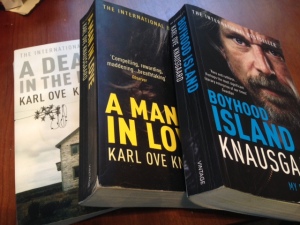 On Monday 2nd November Svetlana Alexievitch, Nobel Laureate, came to the Odeon Theatre, Paris. Under discussion was her latest book ,recently translated into French as La Fin de L’Homme Rouge [Second-hand Time in English] ,and her work in general.
On Monday 2nd November Svetlana Alexievitch, Nobel Laureate, came to the Odeon Theatre, Paris. Under discussion was her latest book ,recently translated into French as La Fin de L’Homme Rouge [Second-hand Time in English] ,and her work in general.
Born in USSR in what is now Belarus , her writing spans 30 years following the Soviet Union from the aftermath of WW2 through its decline and eventual fall.She is living in Minsk currently but her work caused her to live abroad for much of her professional life as it proved displeasing to the powers that be.
She is an unusual Nobel winner in that her work is non fiction. Described as ‘polyphonic writing’ by the Nobel Committee, she uses interviews with ordinary people to document the events that have touched their lives….WW2, the Soviet invasion of Afghanistan, Chernobyl and most recently the collapse of the Soviet Empire.
During the evening extracts from two of her books (Second-hand Time and War’s Unwomanly Face) were read beautifully by French actor Feodor Atkine. She was interviewed by French journalist Sylvain Bourmeau. The questions were asked in French then translated into Russian for Alexievitch by Alissa Kats, who then translated the replies into French for the audience. As I struggled to take notes in English from the French Q&A , I was filled with admiration for the translator’s skills. What follows will ,I hope ,give a flavour of the evening.
Bourmeau asked how she had found the ‘voice’ for her writing. Alexeivitch started as a journalist. She was born in a village in Belarus just after WW2 (1948). There were no men other than one or two old ones, just women. Women who led very hard lives but who would get together and swap stories at the end of a days work. She grew up listening to these voices and came to realise that they were rarely heard in literature. She has tried to transcribe this voice .
She acknowledged her debt to the writer Ales Adamovitch who tried something similar with his book’ I’m From The Burned Village’ in which he interviewed the few survivors of a nazi reprisal. A whole village was burned in retribution for a partisan attack. In it she recognised her own voice and childhood and she loved this book.
To her own work she has added the dimension of time. She is of a different generation to Adamovitch. Who is Stalin is no longer the most important question. Today’s questions are more metaphysical.
Bourmeau wondered how she had perfected her interview technique. Alexievitch denied she had one! There is not one way of doing it , it really depends on the person and the subject.She finds that in general it is more difficult to interview men as there she is entering a different space. This is especially true when they are speaking about war……..she finds there is always a certain contempt or mistrust.
Most people are happy to speak in banalities. If you want something different you have to ask the question in a new way that makes them reflect. For example, when interviewing an Afghan veteran about his war experiences she asked him not what was it like but how did you not go mad with what you had to see and what you had to do?
Bourmeau then asked how she managed to navigate time……..her work spans WW2 through Afghanistan, Chernobyl and now the fall of the Soviet Union. She doesn’t approach history in that way. It is always the person that interests her. Inside each individual are many people and a time but she is interested in l’homme eternel ,that is unchanged since classical times.
For example, a female tank soldier in WW2 told her the worst attacks were those that took place at dawn. She would see the sun rising, hear the birds singing and think that she may not see the end of the day. An Afghan veteran told her that when he was fighting he was only 19 . He didn’t want to die , he wanted to live, get married ,have a family. These things are unchanged over centuries. Putting it all together is what makes it literature.
Bourmeau knows as a journalist that it is very easy to put yourself into the person you are interviewing. How does she manage that? Alexievitch listens and then she has to transform the oral into the written.She has to reduce what is sometimes several hours of speaking into perhaps half a page of text as well as preserve the person she was speaking to. She has to reproduce what she heard, an époque, a person…..that is always very difficult. She is interested in what she calls the language of tears – the ideas, the energy, the emotion.
Bourmeau asked why she decided to write this book which she has described as being one of her most difficult. To Alexievitch it did seem the logical next step to write about the aftermath of the USSR. This, together with her book about Chernobyl ( Voices From Chernobyl) have proved the most difficult. They were both completely new subjects. With WW2 there are whole libraries of books you can consult. Chernobyl was a mystery … there people were describing a fear of the earth, the air, the food.
After the fall of the empire, the Soviet Union divided into 15 different countries. Everything had been destroyed so that something could be reborn. The red man was still there but he was living in a different way.It was difficult to write about that.
Bourmeau wondered whether finding a title helped her to organise the material. Does it take a lot of time to put it together?
It is difficult to put together but there are usually 10 -15 accounts that stand out. Her aim is to put them together almost like a Greek chorus . They sing a history but there is always a vision beyond that. It is hard to describe how you do it…….you can’t ask Shostakovich how he put together his symphonies! At times it feels like she is fighting against chaos. Is there a limit to the horrors a person can take? How does man preserve his humanity ? These are the questions she is constantly exploring.
Alexievitch has described that the writing of her current work focussing on love and getting old is proving difficult to interview people about. Former soviet people find it hard to talk about individual emotions. Is there anything of the soviet still in her, Bourmeau wondered.
When she reviews the diaries that she has kept from a young age, Alexievitch thinks she has been a dissident from the cradle. The war in Afghanistan completely freed her from sovietism.
When she travels and sees people begging on the streets she finds that very hard. She always wants to give money. That is the soviet in her, she thinks. Every person deserves the wherewithal to live…..that was part of the revolution. In the gulags there were many idealists.
Bourmeau pointed out that in her art, Alexievitch has opted for a documentary style and now she had received the Nobel prize rarely given for non fiction. Does she think this means a new form of writing has been recognised.
In painting new forms are welcomed and accepted all the time, in music too.In literature we seem more conservative. She is pleased if a new form has been recognised but she doesn’t think about it much. She feels very lucky to be doing what interests her , her work remains important to her and she enjoys it.
Bourmeau wondered whether the international recognition that the Prize has given her would help her to raise the concerns she has in her own country.
That is a difficult question to answer when you live in an authoritarian regime. A dictator doesn’t much care about the Nobel Prize for Literature. At times she feels helpless but she has always thought it is important to resist power.
A wonderful evening in a beautiful venue.

















